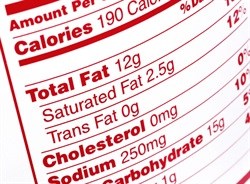






Similarly, only authorised nutrient content claims may be made eg. low fat or high in protein. No claims are allowed to be made around antioxidants or that a food assists in reduction of disease risk.
There are other health considerations when reading food labels. While the fat and calorie content is important, other ingredients, such as sodium, can affect how healthy a product is. Food labels can sometimes be confusing, especially if the front of the product proclaims that it is low in sodium but the information on the label lists sodium in the top few rows of the nutritional value information. This means that sodium is one of the primary ingredients in the product, since the label has to reflect the weights of ingredients from the highest to the lowest, in order.
If an ingredient is highlighted either through the product name or through pictures, the percentage contained in the product must be declared in the ingredients list. Information on the major eight allergens must either be declared in the ingredients list or stated as 'contains' at the end of the ingredients list.
Another vital detail on labels is the sell-by or use-by date, known as the durability date. Durability dates are the dates that detail when the product is no longer of a desired quality and/or safety. There has been much discussion on this of late, as durability dates are pushing up food wastage of perfectly edible food, as the product may still be safe for consumption, but just lost some crunch or flavour. However, products that can become unsafe from microbial contamination require a use-by date and not a best-before date, because a best-before date refers only to the shelf life of an unopened product. This is to protect the consumer.
These pointers are just a few of the things consumers can look out for, for South African labelling laws are comprehensive. For example, the legislation stipulates that the name and address of the manufacturer should be clearly visible and that the storage instructions must be for both before opening and after opening the product. They must be such not only that the product is safe for consumption at the end of shelf life, but also of the expected quality.
It is a demanding process to comply with these regulations and one applauds the local food producers that fulfil all the labelling requirements.
